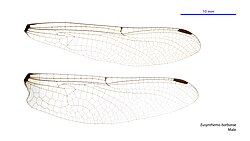| Mount Lewis tigertail | |
|---|---|
| Scientific classification | |
| Kingdom: | Animalia |
| Phylum: | Arthropoda |
| Class: | Insecta |
| Order: | Odonata |
| Infraorder: | Anisoptera |
| Family: | Synthemistidae |
| Genus: | Eusynthemis |
| Species: | E. barbarae |
| Binomial name | |
| Eusynthemis barbarae | |
 | |
Eusynthemis barbarae is a species of dragonfly of the family Synthemistidae, [3] [4] known as the Mount Lewis tigertail. [5] It is a medium-sized dragonfly with black and yellow markings. [5] It inhabits rainforest streams in north-eastern Australia [6] [7]
Contents
Eusynthemis barbarae appears similar to Eusynthemis guttata which is found in streams of south-eastern Australia. [5]


